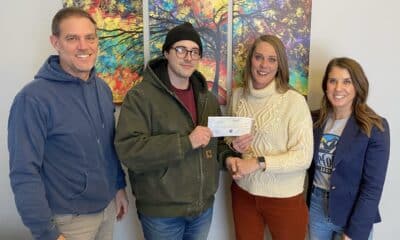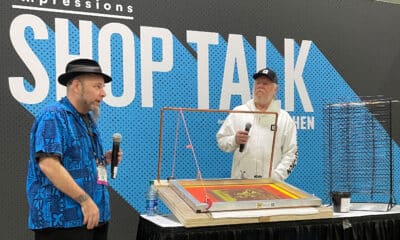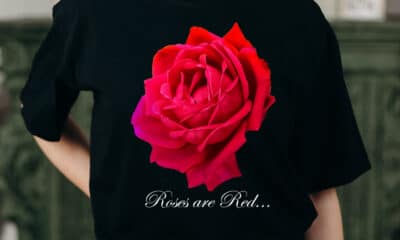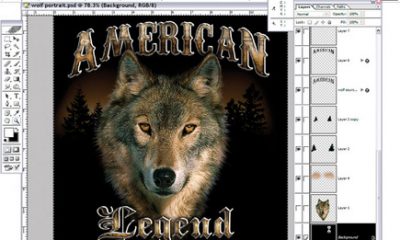Digital Printing
Published
12 years agoon
In this article, we interviewed ten printers and asked them to share a few of the more difficult, but satisfying, applications produced with UV inkjet printing. Keep in mind that business size, market focus, expertise, and experiences are very different. The one common thread is that each company used UV inkjet printing as a way to expand business.
Severn Graphics, Inc.
Glen Burnie, MD
Jeff Sparhawk, VP
In this article, we interviewed ten printers and asked them to share a few of the more difficult, but satisfying, applications produced with UV inkjet printing. Keep in mind that business size, market focus, expertise, and experiences are very different. The one common thread is that each company used UV inkjet printing as a way to expand business.
Severn Graphics, Inc.
Glen Burnie, MD
Jeff Sparhawk, VP
Severn Graphics bought a flatbed UV inkjet printer in 2005 and has since been able to provide a broader and more architecturally exciting variety of substrates into play. In turn, the company’s designers can give customers a more unique graphical element in their interior and exterior designs. It also reduced the amount of steps that go into producing rigid graphics, making it more economical for the client in the long run.
Severn took on a job that involved covering the exterior walls, windows, and gates of an abandoned, prominent landmark in downtown Baltimore, MD (Figure 1). The wall surfaces were a mixture of materials. Severn used its Durst Rho 205/16 to produce the graphics on more than 200 5 x 10-ft sheets of 6-mm corrugated plastic and installed the pieces like tiles around the entire perimeter of the area after just one week of notice.
Making images that fit unusually large sizes involves measuring the space ahead of time very carefully. The Morris Mechanic Theater in Baltimore, MD, required such advance planning. There, Severn calculated the space’s dimensions and then printed and installed graphic panels with interesting images that appeared to be reflections but allowed see-through window viewing as well (Figure 2).
Another noteworthy job was the production of floating ceiling panels for an aircraft company in Seattle, WA (Figure 3). “The client had a very upscale waiting room with 30-foot ceilings, designed as a meeting spot for corporate jet flyers,” Jeff Sparhawk says.
The architects wanted to give the feeling of a lowered, floating ceiling with an aircraft turbine graphic that was repeated throughout the space, but they didn’t want an opaque image that simply looked like mounted prints. Severn Graphics engineered a cable system to hang acrylic panels that had turbines printed on them in such a way that light could flow through this creative design element. Severn printed directly to 0.375-in.-thick acrylic and used partial varnish and a partial white channel.
Astek Inc.
Van Nuys, CA
Aaron Kirsch, president and owner
Astek Inc. purchased its first UV inkjet printer five years ago. The company now has four Dursts, including flatbed and roll-to-roll units. Even with using more UV inkjets, the company has been running 24/7 for the last 15 months as they attempt to keep up with wallpaper orders from large retail stores, nightclubs, hotels, and restaurants.
“They’re our lifeblood,” Aaron Kirsch says. UV inkjet is cleaner, eco-friendly without VOCs, faster, holds registration, and offers more diversity in the material that you print on (foils, naturals, recycled, canvases, etc.), he explains. Astek is now an all-digital operation.
The Venetian Hotel Macau hired Astek to print all of the interior graphics for guest suites. The client originally wanted the walls to be hand-painted, but time constraints prevented it. Astek could deliver the wallpaper in three weeks by using its Durst 500 to print 54-in.-wide rolls three up in lengths of 250 yd.
How did they start it? Ten in-house graphic designers worked together to come up with a classical Asian theme with birds and flowers that looked just right. The next step was a day-and-night print run. The hotel opens for business in November, 2011 with wallpaper installed. In this case, the creativity Astek brought to the project, the focus on turnaround time, and the capability of roll-to-roll UV inkjet printing really made a difference.
Photocenter Imaging
Burbank, CA
Boris Winograd, executive VP
Photocenter Imaging started out as the processing and printing arm of J.H. Maddocks Professional Photography. Eventually the company began providing custom color and black-and-white photos for outside customers. Photocenter still works in photography and offers screen printing, lithography, content creation, digital printing, and finishing. The company purchased an Océ Arizona 350 XT flatbed UV inkjet printer in June of 2009.
“We have the one 8 x 10-ft flatbed, and that’s unusually high for our field,” Boris Winograd says. He explains that the screen-printing process works well for hundreds or thousands of one, but the inkjet does one to a hundred prints in shorter runs, which works out well for Photocenter’s clients. “The ability to do a one-off or fit shorter runs makes it easier in our field of fashion graphics.”
Most of the company’s work is in P-O-P campaigns with Fortune 500 cosmetics and fashion companies, though Photocenter also does package prototypes and special-event graphics. For example, Photocenter Imaging prints 200 lids at a time for custom candy tins (Figure 5). According to Winograd, the white ink gives the company the right opacity to color match any tin and can be printed on demand.
The Ad Art Company
Vernon, CA
Joe DeMarco, co-owner
The Ad Art Company has moved forward progressively from a traditional screen-printing and litho company to one embracing inkjet as the business grew. The company operates as a one-stop shop for unique P-O-S printing and packaging solutions. A recent investment in UV inkjet equipment added three HP FB7500 flatbed UV inkjet printers, an HP Scitex Turbojet, and an HP 2750 hybrid to Ad Art’s mix of more than 12 inkjets. The company still uses inline screen-printing systems.
“Inkjet printers have added a great deal of flexibility and diversity to our operation, as well as being a supplement to our three mid- to large-format inline screen-printing presses,” Joe DeMarco says.
One of the more challenging applications is producing an entire roll-out for clients who demand brand integrity (Figure 6). Color matching is critical when the client requires consistency across printing platforms. Litho, digital, and screen printing converge for the same roll-out—all on different substrates.
According to DeMarco, Ad Art incorporates a stringent set of procedures and guidelines throughout production to ensure the consistency and quality of each print. Among these is a color-management program aligned to the G7 specification that involves constant monitoring and calibrating of all equipment, including cross-reference measurements to color standards. Ad Art is certified as a G7 Proof-to-Press Master. G7 is based on ISO 12647-2 and focuses on using RIP curves to achieve a more consistent visual appearance in neutral gray tones.
Holland & Crosby
Mississauga, Ontario, Canada
Scott Holland, VP sales and marketing, equity partner
Holland & Crosby first invested in a UV inkjet printer in October of 2004. At present, the company has an Inca Onset S70, an Inca Onset S20, and a Durst Rho 320R. Having three UV inkjet printers allows the company to increase its speed to market, realize greater efficiency, and lower costs for customers.
Holland & Crosby used this combination of flatbed and roll-to-roll digital presses to produce three-dimensional locker images within a tight timeline for Foot Locker Canada’s Back to School program. The window display was designed to look like a locker and attach to an pole system at retail locations (Figure 7). By building a full-size prototype of the locker and using digital technology to print the piece, Holland & Crosby was able to show the client an accurate sample beforehand.
Once the prototype was approved, the company had four business days to produce, cut, assemble, pack, and ship the units. Scott Holland estimates that were it not for the digital presses, the breaks in the print run for language changes would have made the project a tall task to complete.
Deluxe Design, Inc.
Rio Rancho, NM
Norman C. Ruth, VP
Deluxe Design invested in a Roland LEJ-640 in May of 2011. It was the company’s first foray into digital printing. Deluxe needed the ability to print directly on flexible and rigid media in full color with variable data in as few production steps as possible.
Being new to the process they didn’t know really what to expect, and that may have been an advantage. One recent involved printing on a new substrate: guitar pick-guard material from IPI Plastics in multiple passes to build up clear layers.
“To prevent misregistration on the backside print, we designed the graphics as a step/repeat pattern,” Norman Ruth explains. The results are giant picks that feature colorful, 3-D structures (Figure 8).
Timsco
Temple Hills, MD
Keith Pritchard, president
Timsco handles an array of digital and screen-printed advertising for mass-transit authorities, financial and government institutions, P-O-P, and trade-show displays. The company invested in UV inkjet technology in 2005.
Keith Pritchard says the company has three Fujifilm Acuity UV flatbeds and notes that digital imaging has kept the company in business and is rapidly taking over screen-printing sales. According to Pritchard, the most challenging applications are two-sided prints, those with spot-color printing, really large production runs, and working with unusual substrates (Figure 9). Color matching can be difficult in spot-color applications, and registration is tough to hold with two-sided prints.
ADJ Group, Inc.
Norwood, MA
Anthony Pace, president
ADJ Group Inc. got its start in UV inkjets in 2006 and now makes use of two Mimaki machines: a UJF-605C and a JF-1631.
“Flatbed UV printing has made a significant difference to our operation,” Anthony Pace says, noting that it has replaced screen printing for most of the short-order runs, increased order throughput, and allowed the company to take on orders that others might veer away from.
The company doesn’t shy away from the tough jobs, either. As a personal project, the ADJ took up printing on laser-engraved wood. The engraving process enables the wood to exhibit textured depth after printing (Figure 10).
The company also produced signs for a laboratory—signs that needed to be resistant to cleaning materials (Figure 11). ADJ made the signs on non-glare acrylic with a subsurface print and appliqué lettering/Raster Braille. The backside of the plaques had steel to attach to a backer plate that was coated with magnetic material.
Albert Screenprint Inc.
Norton, OH
Joe Presto, IT manager
Albert Screenprint began using UV inkjet in 2007, investing in an EFI VUTEk GS3200 and, most recently, in an EFI VUTEk GS3250LX. As in many of the other examples above, Albert Screenprint saw increasing customer demand for a one-stop-shop for promotional programs, including shorter run items. The company began looking for a digital solution that could augment its screen and litho capabilities in a hybrid manufacturing model.
“By producing and finishing everything internally, we have more control over timelines and quality, and we are no longer leaving money on the table using outsource partners,” Joe Presto says. He explains that the new printers enable the company to complete projects on schedule at competitive prices while maintaining a healthy bottom line. It also is a greener technology that uses less energy, produces less waste, and uses less in consumables, he notes.
Albert Screenprint produces pennant strings for bars, restaurants, and special events (Figure 12). They may have a 25- to 30-panel pennant string produced on their litho presses in one design, and the customer may wish to customize the remaining five. The shop uses its inkjet printers to produce made-to-order pennants on double-sided poly that would otherwise be too expensive to customize in short runs on screen or litho presses. In addition, the GS3250LX’s UV-LED curing system enables the use of substrates that are prone to dimensional instability under conventional UV curing.
Take a look around
Printers should look around, see what their competitors can do when pairing inkjet printers with demanding applications, and learn from their successes. It’s called the Prairie Dog Effect. Every so often, and not just at trade shows, you need to pop up your head to get a good perspective. Many of the printers expanded into UV inkjet for short runs, prototypes, one-offs, and streamlined production. By looking at what’s happening around you, it may be possible to best competitors with better, and faster, specialized prints and to be able to hold or improve on price.

Subscribe

Magazine
Get the most important news
and business ideas from Screenprinting Magazine.
Most Popular
-

 Columns1 month ago
Columns1 month ago8 Marketing Mistakes Not to Make When Promoting Your Screen Printing Services Online
-

 Press Releases1 month ago
Press Releases1 month agoSports Inspired Clothing Market: The Influence of Sports on Fashion Forward Looks
-

 Editor's Note1 month ago
Editor's Note1 month agoLivin’ the High Life
-

 Press Releases4 weeks ago
Press Releases4 weeks agoHope Harbor to Receive Donation from BlueCotton’s 2024 Mary Ruth King Award Recipient
-

 Marshall Atkinson1 month ago
Marshall Atkinson1 month agoHow to Create a Winning Culture in Your Screen-Printing Business
-

 Case Studies1 month ago
Case Studies1 month agoScreen Printing for Texture and Depth
-

 News & Trends2 months ago
News & Trends2 months agoWhat Are ZALPHAS and How Can You Serve Them in Your Print Business?
-

 Headlines1 month ago
Headlines1 month agoLive Poster Printing Raises $30K for Charity






